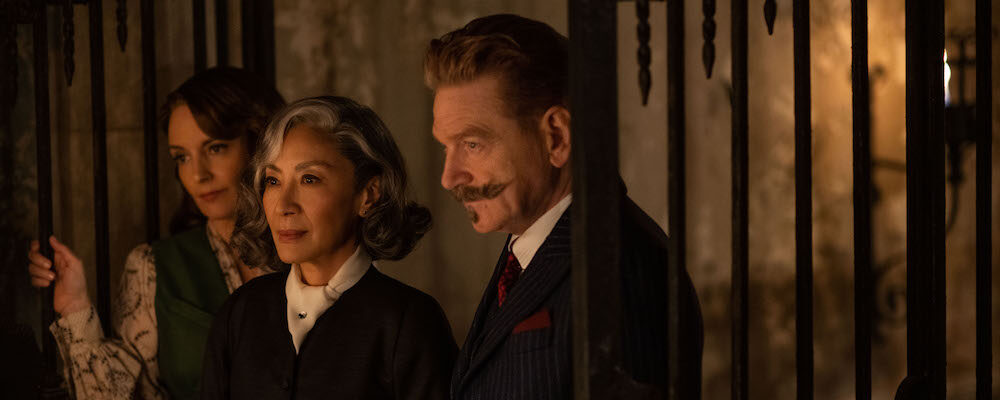‘A Haunting in Venice’: Kenneth Branagh Adds Supernatural Spooks to Agatha Christie Chiller
Alci Rengifo
Some movies really push it when selling themselves as adaptations. Kenneth Branagh’s “A Haunting in Venice” is officially “inspired by” by Agatha Christie’s 1969 novel “Hallowe’en Party.” Aside from using the title to bank off the great author’s name, there’s no connection at all to the original premise or even the setting of the book. This is a new story meant to add a bit of horror to Branagh’s recent line of Christie movies, “Murder on the Orient Express” and “Death on the Nile.” Of the three this one has the most elegance, aiming for atmosphere over the kinetic speediness of its predecessors. A good ensemble is again put together and it is the actors Branagh works with that rise above the plot’s more sluggish attempts at supernatural spooks.
As in the other two movies, Branagh again stars as investigator Hercule Poirot, now retired and living in Venice with watchful bodyguard Vitale Portfoglio (Riccardo Scamarcio). He needs protection from pesky locals begging the legendary sleuth to look into their cases. An old friend drops by, mystery novelist Ariadne Oliver (Tina Fey), who has written novels inspired by Poirot that have fueled his myth. She reminds him that it is Halloween, which Americans have imported to Italy in the post-war years, and would like Poirot to join her at a party. The true occasion is a séance to be held at the party for the host, opera singer Rowena Drake (Kelly Reilly), who hopes medium Mrs. Reynolds (Michelle Yeoh) can contact her tragically deceased daughter. Poirot scoffs at such supernatural notions of course, since he is a man keen on rational evidence. At the gathering a murder occurs and the ensuing search for answers will challenge Poirot’s beliefs.
After two Christie adaptations that stuck close to the murder mystery style the author made iconic, Branagh feels like a filmmaker trying to sustain his own interest in the material. “Murder on the Orient Express” and “Death on the Nile” felt designed to prove Christie could be rebranded for an audience accustomed to rapid editing and popcorn climaxes. Rian Johnson’s “Knives Out” then famously revamped the genre in a way that has yet to be equaled. “A Haunting in Venice” is Branagh almost paying homage to a classic form of Hollywood filmmaking now rare, while also being his first attempt at horror since his bombastic “Mary Shelley’s Frankenstein” in the 1990s. The production design is first rate. Rowena Drake’s palazzo is a home of towering gothic walls, pitch black basements and corridors hiding who knows what. Thunder and rain pound windows and no one can leave until the storm subsides. Regular Branagh cinematographer Haris Zambarloukos uses wide angles and shadows to create atmosphere while winking at classic films like “The Innocents.”
In essence this is an overall moodier mystery than Branagh’s previous deliveries. Poirot is played by the director with a more subdued air, as if he’s tired of the investigator’s life, pondering mortality. The ensemble is entertaining but never too wacky. There’s Jamie Dornan as Dr. Leslie Ferrier, a friend of Drake’s who suffers from World War II PTSD. He is watched over by his young son, Leopold, played by Jude Hill who was fantastic in Branagh’s wonderful “Belfast.” Tina Fey gets edgier than usual with her ambitious writer, feeling the need to find a story worthy of a bestseller, no matter what. Michelle Yeoh, fresh from winning a historic Oscar for “Everything Everywhere All at Once,” is the most relaxed as a medium all too confident of her abilities. Yeoh and Branagh give the movie a real sense of fun in its earlier moments, since Poirot’s rational instincts are pitted against supernatural claims.
Branagh has made a good mystery, even if the screenplay by Michael Green doesn’t always know how to use the ghostly angle. The movie leaves its beliefs open-ended. There’s enough suspense in Poirot using his keen skills to figure out who was where and with whom, putting together potential scenarios to throw us off or keep us guessing. There is no need for a ghost, though there are hints at one when Poirot may wash his face and something borrowed from “The Grudge” flashes in a corner. More enjoyable are moments of classic thrills. Who tried to drown Poirot while he was bobbing for apples? Was the death of Drake’s daughter mere suicide? What invisible force types out letters on a typewriter when Mrs. Reynolds summons answers from the beyond? These are more intriguing than any spirit walking around the palazzo, and to be frank, the spooks amount to little.
What works much better than the scares is how Branagh insists on challenging the audience by letting “A Haunting in Venice” find an immersive pace. We’re so used to rapid fire thrillers that this one surprises with its patience and clues. Like the countless other detectives the character inspired, Poirot has a memory and power of observation no mere human can actually possess, but that’s what also makes these stories a great time. It’s all about that open jar of honey in the kitchen or the way someone entered a room at just the right moment. The resolution to the case is a wild connection of everything Poirot has observed, but though fittingly overly complicated, the motivations behind the crime are heartbreaking and full of plausible madness. “A Haunting in Venice” is being sold as a scary movie yet it’s another good puzzle from Branagh, who goes for a slow burner approach that makes for an elegant mystery. The ghosts dissolve but the fun of the sleuthing remains.
“A Haunting in Venice” releases Sept. 15 in theaters nationwide.

